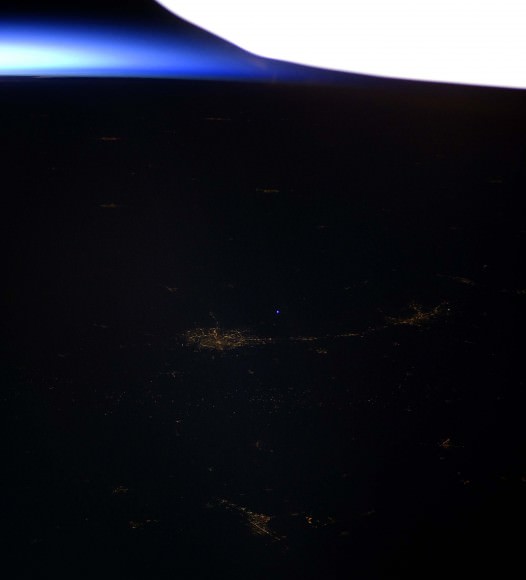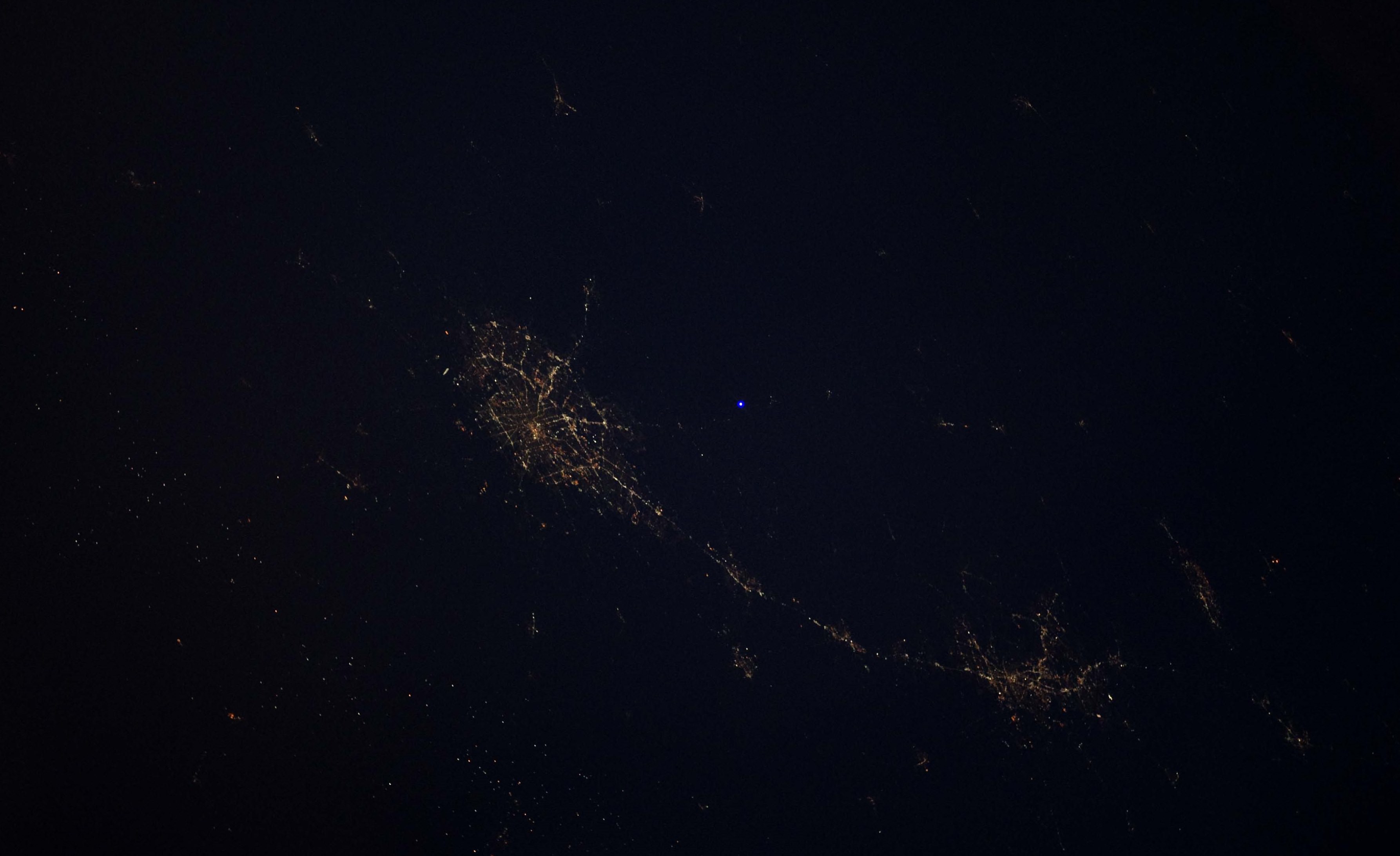[/caption]
We’ve seen lots of images and videos of city lights on Earth as seen from the International Space Station. But if you were down on Earth, flashing a light at the astronauts on the ISS – would they see you? The answer is now definitively, yes. Flashing the space station with beams of light as it passes overhead had never been successfully done—until this past weekend. Astronomers with the San Antonio Astronomy Association (SAAA) and the Austin Astronomy Society combined forces to flash enough light at the ISS from a dark location, as to appear greater than 0 magnitude to astronaut Don Pettit, on board the station. It turns out, they probably didn’t need the two 800 million lumen searchlights they used, but they sure put on a great show.
“It was amazing,” said Keith Little, from the SAAA. “It was almost like the space station lit up when we shined the lights on it. We had no idea it was going to be that bright.”

In a highly coordinated and engineered event, the astronomers flashed the two huge searchlights along with shining a one-watt blue laser at the ISS. Pettit explained some of the preparations in his blog on Fragile Oasis: “This took a number of engineering calculations, Pettit wrote. “Projected beam diameters (assuming the propagation of a Gaussian wave for the laser) and intensity at the target had to be calculated. Tracking space station’s path as it streaked across the sky was another challenge.”
Due to lags in communications to and from the ISS (“on space station we receive email drops two to three times a day,” Pettit said), the whole event took weeks to plan.
The SAAA had an “in” with Pettit, as he is friends with one of their members, astrophotographer and author Robert Reeves, and the idea for doing this was actually hatched before Pettit left for space back in November, 2011.
On March 4, about 65 amateur astronomers were in position at the Lazano Observatory in Springbranch Texas. They turned on the searchlights and waited as the ISS was set to make an appearance in the sky. At the precise time, they began flashing the two searchlights at a rate of two seconds on, then two seconds off, in a very non-technical, but effective manner.
“We had two people manually aiming the lights and two people holding plywood up over the lights, and they were manually tracking the space station,” Little told Universe Today.
Pettit, meanwhile, had no trouble seeing the flashes.
“Don sent us an email the next day,” Little said, “and he told us how bright it was, and how he could see the lights even before we started the flash system. He saw it from 10 degrees above from the west to 10 degrees from the Northeast.”
To everyone’s surprise, Pettit could also see the blue laser. “When the spotlights were off, he said he could still see the blue laser, which was shone steadily,” Little said. “I was pretty surprised that the laser light was that visible from space.”
Little ran the laser and he had three people aiding him by watching for aircraft, “It is an FAA offense to shoot an airplane with a laser, so we took all the safety precautions so that we wouldn’t take that chance,” he said.
But if you see the ISS passing overhead, don’t expect that you can flash a light and they will see it. For one thing, they probably won’t be looking for your light. But additionally, Pettit explained in a previous blog post how when we see the ISS best here on Earth, they can’t see much below.
Ironically, when earthlings can see us, we cannot see them. The glare from the full sun effectively turns our windows into mirrors that return our own ghostly reflection. This often plays out when friends want to flash space station from the ground as it travels overhead. They shine green lasers, xenon strobes, and halogen spotlights at us as we sprint across the sky. These well-wishers don’t know that we cannot see a thing during this time. The best time to try this is during a dark pass when orbital calculations show that we are passing overhead. This becomes complicated when highly collimated light from lasers are used, since the beam diameter at our orbital distance is about one kilometer, and this spot has to be tracking us while in the dark. And of course we have to be looking. As often happens, technical details complicate what seems like a simple observation. So far, all attempts at flashing the space station have failed.
But of course, now there has been a success.
Little said the two astronomy clubs put in 3 months of planning with several meetings, and thanks do the donation of the spotlights from SkyView Searchlights, the costs to do the experiment were minimal. “We had lots of volunteers who wanted to be a part of it,” he said.
Is there any science in this, beyond knowing that under the right conditions the ISS astronauts could see lights from people on Earth?
“Well, if the ISS were to somehow lose all communication, which I would find hard to believe, we just showed that we could spot the station and possibly send them messages through Morse code,” Little said.
But Little said the main thrust of the whole event was the novelty of trying to be the first to successfully shine a light at the ISS that the crew could see, as well as trying to bring astronomy to the attention of the general public.


So cool!!!
I had a totally different image im my mind when I first read the title. 😀
I can hear it now: “Ahh Houston, we are being flashed by a perv outside of NYC” LMAO
100-billion dollar science : the flashlight works!
Couldn’t think of better ways to spend the money.
Martin, are you being deliberately obtuse, or are you being sarcastic? I ask because any other answer would mean that you are not very bright, and could not flash the ISS yourself ! 🙂
Although I think it is a fun experiment, I was actually being sarcastic.
If you follow a bit what’s going in the ISS, it’s amazing how much nonsense science is being produced in this expensive lab : getting flashed (with a flashlight that is), trying to iron your clothes in microgravity, telecon with the pope, and over and over again the drinking form a floating bubble. I’m having difficulties to see the scientific benefits in this.
But don’t get me wrong, a lot of useful science is actually done in the ISS, it is a truly wonderful platform!
While the merit of many experiments on the ISS can certainly be debated, this particular one was funded by the SAAA – the ISS had no input beyond an astronaut looking out of the window at a specified time (which probably didn’t add much to the ISS budget)
All those things you mention are indeed silly to the point of “Meh”. They are just PR Video opportunities to keep the groundlings interested in the ISS. No harm, No foul. And I agree that there is real science being done on the ISS.
They’re doing lots of stuff up there. http://www.nasa.gov/mission_pages/station/research/experiments_category.html
How neat! Probably one of the few times that astronomers actually wanted their observatory lit up at night.
I appreciate the validation given for which a hand held 1 Watt laser pointer was used in a productive, scientific, and Lawful manner. As a LaserPointerForums enthusiast I am especially impressed at the high level safety conscious effort and attention paid by these Amateur Astronomers toward insuring there were no aircraft visibly present in the laser field of view.
Nancy, without a doubt you and these Amateur Astronomers deserve Kudos for increasing awareness that a moderate power rated laser pointer of this type can be used in a safe and professional manner to provide significant scientific benefit as was demonstrated in this carefully planned and executed exercise.
1. What sort of power and color are you looking for in a laser? This usually will depend on your experience with lasers, as well as the application you’re looking to accomplish. If you need distance and burning ability the higher the mW power the better suited your laser will be.
It’s just FANTASTIC 😀